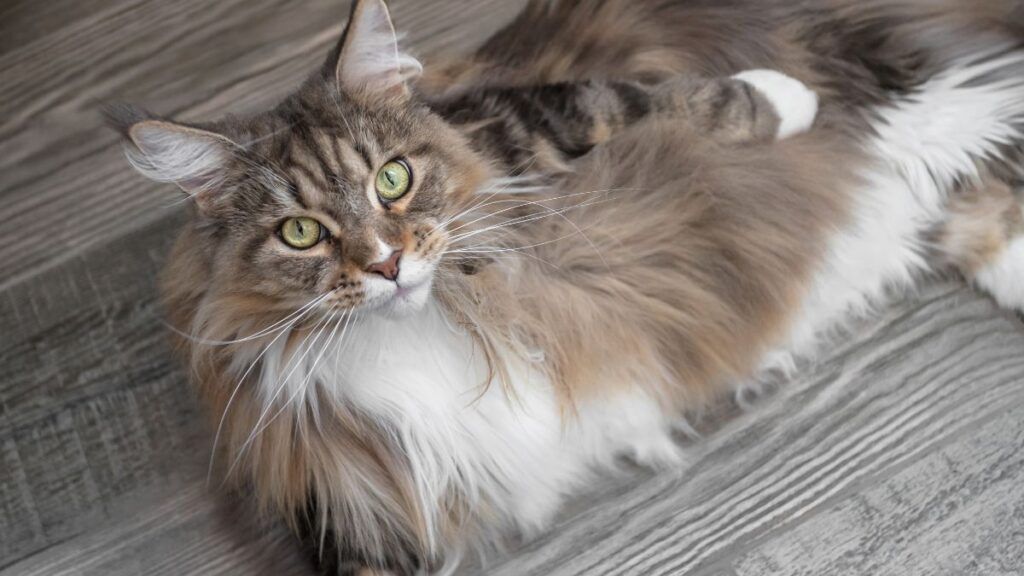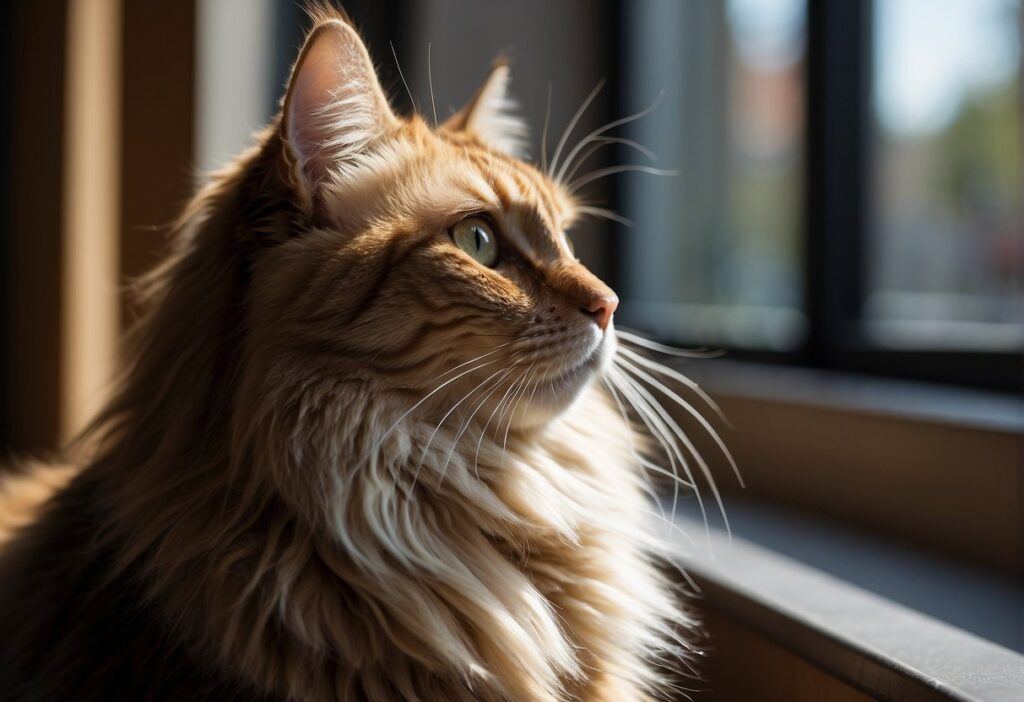Hair length is a significant factor for cat owners and breeders. Long-haired cats like Persians and Maine Coons are admired for their luxurious coats.
Short-haired breeds such as American Shorthairs and Siamese are appreciated for their ease of care.
Choosing between long and short hair affects grooming needs, shedding, heat tolerance, and the pet’s overall maintenance.
Personal preference often guides this decision, with some preferring the plush feel and grandeur of long hair while others opt for the practicality of short-haired cats.
Beyond aesthetics, practical considerations include the commitment to grooming—long-haired cats need regular brushing to avoid matting, whereas short-haired cats require less upkeep.
Another concern is allergy, as longer hairs can hold more dander. Ultimately, choosing a cat’s hair length involves balancing visual appeal with the practicalities of care and lifestyle compatibility.
Physical Characteristics of Cat Hair

Cat hair varies by length and type, which can influence the appearance and grooming needs of different breeds of cats.
Understanding Hair Length Categories
In cats, hair length falls into three primary categories: long hair, medium hair, and short hair.
Long-haired cats, including domestic longhairs, have long coats that often look luxurious and require consistent grooming.
Medium-haired cats strike a balance between the maintenance of long and short hairs, with a moderate length that can occasionally form a fluffy tail.
Short-haired cats, such as the domestic shorthair, have a short hair coat that is typically easier to care for, reducing the likelihood of matting and tangling.
Coat Length Variations
Different breeds exhibit a range of coat lengths and characteristics:
- Long-haired cats: Known for their elegant, flowy fur, which demands regular brushing to prevent knots.
- Medium-haired cats: They have varied coats that can sometimes resemble the fullness of long coats but require less grooming.
- Short-haired cats: Feature a sleek, dense coat that is generally low-maintenance, making them a practical choice for many owners.
The Science Behind Fur Types
The genetics of cats largely determine the length and type of their fur.
A mutation in the fibroblast growth factor 5 (FGF5) gene is responsible for cats’ long hair variant.
This gene influences the hair growth cycle, and mutations leading to longer coats have been selected for various breeds.
Hormonal changes and environmental factors can also affect the condition and growth rate of a cat’s hair, whether long, medium, or short.
Grooming and Maintenance Requirements

Choosing between a long-haired feline and a shorthair breed like the British Shorthair or American Shorthair impacts grooming needs.
Considerations such as regular brushing, shedding management, and professional grooming must be addressed for the health and cleanliness of the cat.
Regular Brushing and its Importance
Long-haired cats require regular brushing to prevent mats and tangles, which can lead to skin problems.
Using a good brush that reaches the undercoat is vital, as it helps to remove excess hair and distribute natural skin oils.
In contrast, shorthair breeds typically need less frequent brushing due to their shorter coats.
- Long-haired felines: Brush several times a week.
- British Shorthair: Brush once a week.
- American Shorthair: Brush once every two weeks.
Dealing with Shedding
Shedding is a natural process, with long-haired breeds often releasing more hair.
Regular grooming minimizes the amount of hair around the house and on clothes.
A shorthair cat may be preferable for less hair cleanup, while a fluffy cat will require more frequent attention to manage the shedding.
- Vacuuming regularly: Necessary for homes with long-haired cats.
- Lint rollers: A must-have tool for owners to tackle hair on furniture and clothing.
Professional Grooming Needs
While many grooming tasks can be managed at home, some owners may opt for a professional groomer.
This is especially beneficial for long-haired felines prone to severe matting or owners uncomfortable with tasks like nail trimming.
Professional grooming can help prevent health problems and ensure the cat’s skin and coat remain healthy.
- Professional grooming: Recommended every 4-6 months for long-haired cats.
- Self-grooming: Shorthair breeds with less hair generally require fewer professional grooming sessions.
Health and Genetics of Long/Short Hair Cats

The relationship between hair length in cats and potential health issues is a focal point for cat owners. Genetics play a key role in determining a cat’s hair type and may impact their overall well-being.
Common Health Issues in Long vs. Short Hair Cats
Long-haired kittens and cats, such as Persians and Maine Coons, are predisposed to matting and hairballs, which can cause digestive issues if not properly groomed.
Regular brushing is essential to prevent these problems.
On the other hand, short-haired kittens and cats typically require less grooming but can still suffer from hairballs.
Both long and short-haired cat breeds can experience common feline health issues, such as dental disease, obesity, and urinary tract problems.
It is important for owners to monitor their cats’ health regardless of hair length.
Genetic Factors Affecting Hair Type
Hair length in cats is influenced by genetic mutations.
The fibroblast growth factor (FGF5) gene plays a crucial role in determining hair length.
A mutation in this gene is what typically leads to the long hair seen in breeds like Ragdolls and Norwegians.
Medium-haired breeds can also arise through a combination of genetic factors.
Genes inherited from parent cats determine whether a kitten will have long, medium, or short hair.
It’s integral for breeders to understand these hereditary patterns, as they can inform breeding strategies and help predict the characteristics of future litters.
Related: Unlock the Secrets of Feline Care: Medium vs Long Haired Cats
Considerations for Choosing a Cat
Choosing between a long hair cat and a short hair cat involves considering factors such as climate and household environment.
These considerations can help determine the most suitable feline companion for your home.
Climate and Environmental Factors
Climate plays a significant role in the decision-making process.
Long hair cats:
- May require more grooming in hot climates to avoid overheating.
- Can thrive in cooler temperatures due to their thick coats.
Short hair cats:
- Are often better suited for warmer climates.
- Require less grooming, making them a good choice for those in areas with high temperatures.
Table 1: Climate Suitability
| Type of Cat | Cooler Climates | Warmer Climates | Grooming Needs |
|---|---|---|---|
| Long Hair Cats | Suitable | Less Suitable | High |
| Domestic Medium Hair | Moderate | Moderate | Moderate |
| Domestic Short Hair | Less Suitable | Suitable | Low |
New Cat Owner Recommendations
For new cat owners, taking on the responsibility of a new kitten or cat comes with the need to understand care requirements.
Long hair and domestic medium hair cats:
- May require more time and commitment due to grooming needs.
- Could be overwhelming for first-time cat owners who aren’t acquainted with grooming routines.
Domestic short hair cats:
- Less demanding in terms of grooming.
- Often recommended for new cat owners as they typically need less maintenance.
List of Recommendations for New Cat Owners:
- Consider a domestic short hair cat if seeking a low-maintenance pet.
- Evaluate your available time for grooming if considering a long hair cat.
- Remember that all cats, regardless of coat length, need regular veterinary care and attention.
Introducing Cory Haasnoot, a devoted father, loving husband, and enthusiastic cat lover. As a key content creator for CatFurLife.com, Cory blends his family values and passion for felines into engaging and informative content. He brings a unique perspective to the site, sharing cat care tips and how cats can enrich family life and bring joy to households.

